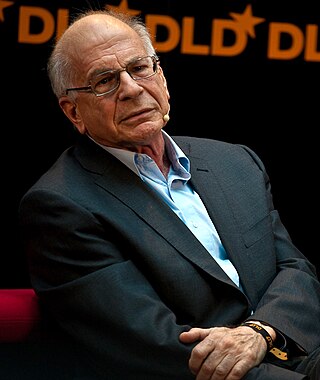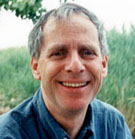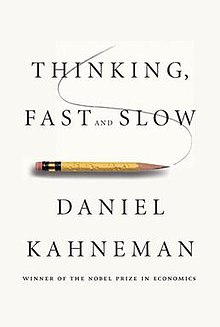
A cognitive bias is a systematic pattern of deviation from norm or rationality in judgment. Individuals create their own "subjective reality" from their perception of the input. An individual's construction of reality, not the objective input, may dictate their behavior in the world. Thus, cognitive biases may sometimes lead to perceptual distortion, inaccurate judgment, illogical interpretation, and irrationality.
A heuristic, or heuristic technique, is any approach to problem solving or self-discovery that employs a practical method that is not guaranteed to be optimal, perfect, or rational, but is nevertheless sufficient for reaching an immediate, short-term goal or approximation. Where finding an optimal solution is impossible or impractical, heuristic methods can be used to speed up the process of finding a satisfactory solution. Heuristics can be mental shortcuts that ease the cognitive load of making a decision.

Daniel Kahneman is an Israeli-American author, psychologist and economist notable for his work on hedonic psychology, psychology of judgment and decision-making. He is also known for his work in behavioral economics, for which he was awarded the 2002 Nobel Memorial Prize in Economic Sciences. His empirical findings challenge the assumption of human rationality prevailing in modern economic theory.

Amos Nathan Tversky was an Israeli cognitive and mathematical psychologist and a key figure in the discovery of systematic human cognitive bias and handling of risk.

Behavioral economics is the study of the psychological, cognitive, emotional, cultural and social factors involved in the decisions of individuals or institutions, and how these decisions deviate from those implied by classical economic theory.
The availability heuristic, also known as availability bias, is a mental shortcut that relies on immediate examples that come to a given person's mind when evaluating a specific topic, concept, method, or decision. This heuristic, operating on the notion that, if something can be recalled, it must be important, or at least more important than alternative solutions not as readily recalled, is inherently biased toward recently acquired information.

Decision theory is a branch of applied probability theory and analytic philosophy concerned with the theory of making decisions based on assigning probabilities to various factors and assigning numerical consequences to the outcome.
The representativeness heuristic is used when making judgments about the probability of an event being representional in character and essence of known prototypical event. It is one of a group of heuristics proposed by psychologists Amos Tversky and Daniel Kahneman in the early 1970s as "the degree to which [an event] (i) is similar in essential characteristics to its parent population, and (ii) reflects the salient features of the process by which it is generated". The representativeness heuristic works by comparing an event to a prototype or stereotype that we already have in mind. For example, if we see a person who is dressed in eccentric clothes and reading a poetry book, we might be more likely to think that they are a poet than an accountant. This is because the person's appearance and behavior are more representative of the stereotype of a poet than an accountant.
The conjunction fallacy is an inference that a conjoint set of two or more specific conclusions is likelier than any single member of that same set, in violation of the laws of probability. It is a type of formal fallacy.

Gerd Gigerenzer is a German psychologist who has studied the use of bounded rationality and heuristics in decision making. Gigerenzer is director emeritus of the Center for Adaptive Behavior and Cognition (ABC) at the Max Planck Institute for Human Development and director of the Harding Center for Risk Literacy, both in Berlin.

The simulation heuristic is a psychological heuristic, or simplified mental strategy, according to which people determine the likelihood of an event based on how easy it is to picture the event mentally. Partially as a result, people experience more regret over outcomes that are easier to imagine, such as "near misses". The simulation heuristic was first theorized by psychologists Daniel Kahneman and Amos Tversky as a specialized adaptation of the availability heuristic to explain counterfactual thinking and regret. However, it is not the same as the availability heuristic. Specifically the simulation heuristic is defined as "how perceivers tend to substitute normal antecedent events for exceptional ones in psychologically 'undoing' this specific outcome."
The overconfidence effect is a well-established bias in which a person's subjective confidence in their judgments is reliably greater than the objective accuracy of those judgments, especially when confidence is relatively high. Overconfidence is one example of a miscalibration of subjective probabilities. Throughout the research literature, overconfidence has been defined in three distinct ways: (1) overestimation of one's actual performance; (2) overplacement of one's performance relative to others; and (3) overprecision in expressing unwarranted certainty in the accuracy of one's beliefs.
In psychology, the human mind is considered to be a cognitive miser due to the tendency of humans to think and solve problems in simpler and less effortful ways rather than in more sophisticated and effortful ways, regardless of intelligence. Just as a miser seeks to avoid spending money, the human mind often seeks to avoid spending cognitive effort. The cognitive miser theory is an umbrella theory of cognition that brings together previous research on heuristics and attributional biases to explain when and why people are cognitive misers.
Attribute substitution is a psychological process thought to underlie a number of cognitive biases and perceptual illusions. It occurs when an individual has to make a judgment that is computationally complex, and instead substitutes a more easily calculated heuristic attribute. This substitution is thought of as taking place in the automatic intuitive judgment system, rather than the more self-aware reflective system. Hence, when someone tries to answer a difficult question, they may actually answer a related but different question, without realizing that a substitution has taken place. This explains why individuals can be unaware of their own biases, and why biases persist even when the subject is made aware of them. It also explains why human judgments often fail to show regression toward the mean.
Heuristics is the process by which humans use mental shortcuts to arrive at decisions. Heuristics are simple strategies that humans, animals, organizations, and even machines use to quickly form judgments, make decisions, and find solutions to complex problems. Often this involves focusing on the most relevant aspects of a problem or situation to formulate a solution. While heuristic processes are used to find the answers and solutions that are most likely to work or be correct, they are not always right or the most accurate. Judgments and decisions based on heuristics are simply good enough to satisfy a pressing need in situations of uncertainty, where information is incomplete. In that sense they can differ from answers given by logic and probability.
Insensitivity to sample size is a cognitive bias that occurs when people judge the probability of obtaining a sample statistic without respect to the sample size. For example, in one study, subjects assigned the same probability to the likelihood of obtaining a mean height of above six feet [183 cm] in samples of 10, 100, and 1,000 men. In other words, variation is more likely in smaller samples, but people may not expect this.
Illusion of validity is a cognitive bias in which a person overestimates their ability to interpret and predict accurately the outcome when analyzing a set of data, in particular when the data analyzed show a very consistent pattern—that is, when the data "tell" a coherent story.
Cognitive bias mitigation is the prevention and reduction of the negative effects of cognitive biases – unconscious, automatic influences on human judgment and decision making that reliably produce reasoning errors.
Social heuristics are simple decision making strategies that guide people's behavior and decisions in the social environment when time, information, or cognitive resources are scarce. Social environments tend to be characterised by complexity and uncertainty, and in order to simplify the decision-making process, people may use heuristics, which are decision making strategies that involve ignoring some information or relying on simple rules of thumb.
Intuitive statistics, or folk statistics, is the cognitive phenomenon where organisms use data to make generalizations and predictions about the world. This can be a small amount of sample data or training instances, which in turn contribute to inductive inferences about either population-level properties, future data, or both. Inferences can involve revising hypotheses, or beliefs, in light of probabilistic data that inform and motivate future predictions. The informal tendency for cognitive animals to intuitively generate statistical inferences, when formalized with certain axioms of probability theory, constitutes statistics as an academic discipline.






